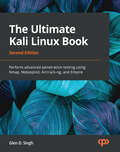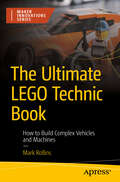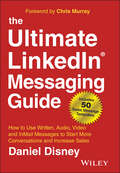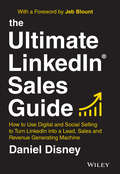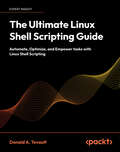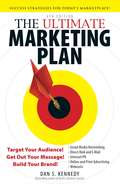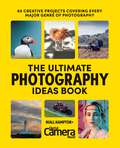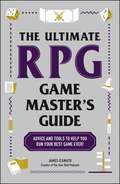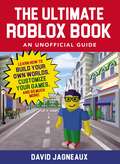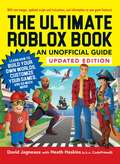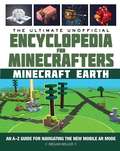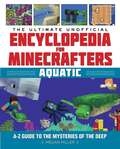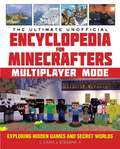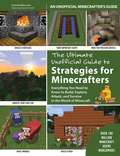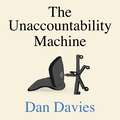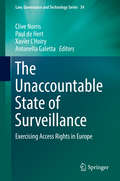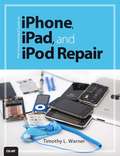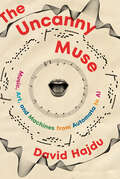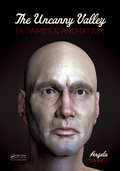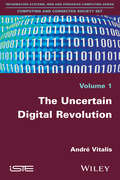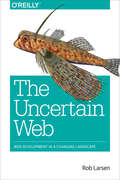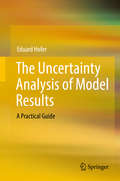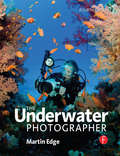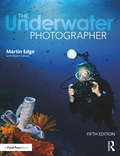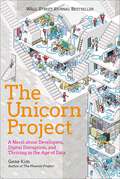- Table View
- List View
The Ultimate Kali Linux Book: Perform advanced penetration testing using Nmap, Metasploit, Aircrack-ng, and Empire, 2nd Edition
by Glen D. SinghExplore the latest ethical hacking tools and techniques to perform penetration testing from scratchPurchase of the print or Kindle book includes a free eBook in the PDF formatKey FeaturesLearn to compromise enterprise networks with Kali LinuxGain comprehensive insights into security concepts using advanced real-life hacker techniquesUse Kali Linux in the same way ethical hackers and penetration testers do to gain control of your environmentBook DescriptionKali Linux is the most popular and advanced penetration testing Linux distribution within the cybersecurity industry. Using Kali Linux, a cybersecurity professional will be able to discover and exploit various vulnerabilities and perform advanced penetration testing on both enterprise wired and wireless networks. This book is a comprehensive guide for those who are new to Kali Linux and penetration testing that will have you up to speed in no time. Using real-world scenarios, you'll understand how to set up a lab and explore core penetration testing concepts. Throughout this book, you'll focus on information gathering and even discover different vulnerability assessment tools bundled in Kali Linux. You'll learn to discover target systems on a network, identify security flaws on devices, exploit security weaknesses and gain access to networks, set up Command and Control (C2) operations, and perform web application penetration testing. In this updated second edition, you'll be able to compromise Active Directory and exploit enterprise networks. Finally, this book covers best practices for performing complex web penetration testing techniques in a highly secured environment. By the end of this Kali Linux book, you'll have gained the skills to perform advanced penetration testing on enterprise networks using Kali Linux.What you will learnExplore the fundamentals of ethical hackingUnderstand how to install and configure Kali LinuxPerform asset and network discovery techniquesFocus on how to perform vulnerability assessmentsExploit the trust in Active Directory domain servicesPerform advanced exploitation with Command and Control (C2) techniquesImplement advanced wireless hacking techniquesBecome well-versed with exploiting vulnerable web applicationsWho this book is forThis pentesting book is for students, trainers, cybersecurity professionals, cyber enthusiasts, network security professionals, ethical hackers, penetration testers, and security engineers. If you do not have any prior knowledge and are looking to become an expert in penetration testing using the Kali Linux operating system (OS), then this book is for you.
The Ultimate LEGO Technic Book: How to Build Complex Vehicles and Machines (Maker Innovations Series)
by Mark RollinsLEGO has come a long way from the days of simple square bricks, and many still associate LEGO with their various playsets. For those that want more advanced building, some LEGO enthusiasts prefer the Technic sets, which feature beams, axles, gears, and other mechanized parts that can be powered and programmed to make fairly complex machines. This book begins with an introduction of basic pieces and building techniques, and there will be instruction of how to build some terrific vehicles that will look like actual cars, planes, and other machines. Not only that, I will instruct how to make these vehicles do all kinds of motion, even steering and walking! After reading this book, the reader will be inspired to create any machine they want. They will also be able to use the programming tools for even more mechanical creations in the future. What You'll Learn How to use beams, axles, gears, and other mechanized parts to create intricate and functional machines. How to create building impressive vehicles with step-by-step instructions. How to innovate and design your unique LEGO creations Learn the basics of Technic to bring creations to life Who This Book Is For This is a book that is made for students but is also made for educators. From the classroom to the adult hobbyist, people from all over the world want to create, thanks to Maker culture. This book will help those who are not certain where to begin with their creations.
The Ultimate LinkedIn Messaging Guide: How to Use Written, Audio, Video and InMail Messages to Start More Conversations and Increase Sales
by Daniel DisneyGet people to read, listen to, and watch your LinkedIn messages The Ultimate LinkedIn Messaging Guide is for salespeople, businesses, recruiters, and LinkedIn users who struggle to get replies and results on the essential business platform. In this book, author Daniel Disney shows you just how powerful LinkedIn can be when you figure out how to do it right. You’ll discover how to use LinkedIn messages to get noticed by employers, get attention to your business, and close deals. When you master LinkedIn messaging with the proven tips inside this book, you’ll be able to start more conversations, create more opportunities and drive more sales and revenue. What you’re looking for is out there – if you know how to reach the people who can help. But in this age of information overload, no one will respond to a spammy message, call, or e-mail. You need to stand out and prove that you’re legitimate. In this book, you’ll find real examples of successful messages, as well as over 50 message templates and scripts for written, audio, video and InMail messages. There are also QR codes throughout the book that take you to recorded examples of video and audio messages so you can see and hear them in action. Learn how to send personalised connection requests and LinkedIn messages that prompt people to talk to you Discover tips for building your network and reaching the decision makers at any company Leverage the power of audio and video messages to connect more effectively on LinkedIn Follow up and convert replies into sales, job offers, and high-value relationshipsIf you’ve struggled to get noticed, meet the right people, and close deals, The Ultimate LinkedIn Messaging Guide is the tool you need to turn it around.
The Ultimate LinkedIn Sales Guide: How to Use Digital and Social Selling to Turn LinkedIn into a Lead, Sales and Revenue Generating Machine
by Daniel DisneyBecome a LinkedIn power user and harness the potential of social selling With the impact of COVID, remote working has become big, and so has the use of digital/virtual sales tools. More sales teams want and need to understand how to use social media platforms like LinkedIn to sell, and most do not use it properly. The Ultimate LinkedIn Sales Guide is the go-to book and guide for utilizing LinkedIn to sell. It covers all aspects of social and digital selling, including building the ultimate LinkedIn profile, using the searching functions to find customers, sending effective LinkedIn messages (written, audio & video), creating great content that generates sales, and all the latest tips and tricks, strategies and tools. With the right LinkedIn knowledge, you can attract customers and generate leads, improving your sales numbers from the comfort and safety of your computer. No matter what you are selling, LinkedIn can connect you to buyers. If you’re savvy, you can stay in touch with clients and generate more repeat sales, build trust, and create engaging content that will spread by word-of-mouth—the most powerful sales strategy around. This book will teach you how to do all that and more. In The Ultimate LinkedIn Sales Guide you will learn how to: Use the proven 4 Pillars of Social Selling Success to improve your existing LinkedIn activities or get started on a firm footing Create the Ultimate LinkedIn Profile, complete with a strong personal brand that could catapult you to industry leader status Generate leads using LinkedIn, then build and manage relationships with connected accounts to turn those leads into customers Utilize little-known LinkedIn “power tools” to grow your network, send effective messages, and write successful LinkedIn articles And so much more! The Ultimate LinkedIn Sales Guide is a must read for anyone wishing to utilise LinkedIn to improve sales.
The Ultimate Linux Shell Scripting Guide: Automate, Optimize, and Empower tasks with Linux Shell Scripting
by Donald A. TevaultMaster Linux Shells – Your Complete Guide to Practical Success with Bash, Zsh, PowerShellKey FeaturesDevelop portable scripts using Bash, Zsh, and PowerShell that work seamlessly across Linux, macOS, and Unix systemsProgress seamlessly through chapters with clear concepts, practical examples, and hands-on labs for skill developmentBuild real-world Linux administration scripts, enhancing your troubleshooting and management skillsBook DescriptionDive into the world of Linux shell scripting with this hands-on guide. If you’re comfortable using the command line on Unix or Linux but haven’t fully explored Bash, this book is for you. It’s designed for programmers familiar with languages like Python, JavaScript, or PHP who want to make the most of shell scripting. This isn’t just another theory-heavy book—you’ll learn by doing. Each chapter builds on the last, taking you from shell basics to writing practical scripts that solve real-world problems. With nearly a hundred interactive labs, you’ll gain hands-on experience in automation, system administration, and troubleshooting. While Bash is the primary focus, you'll also get a look at Z Shell and PowerShell, expanding your skills and adaptability. From mastering command redirection and pipelines to writing scripts that work across different Unix-like systems, this book equips you for real-world Linux challenges. By the end, you'll be equipped to write efficient shell scripts that streamline your workflow and improve system automation.What you will learnGrasp the concept of shells and explore their diverse types for varied system interactionsMaster redirection, pipes, and compound commands for efficient shell operationsLeverage text stream filters within scripts for dynamic data manipulationHarness functions and build libraries to create modular and reusable shell scriptsExplore the basic programming constructs that apply to all programming languagesEngineer portable shell scripts, ensuring compatibility across diverse platforms beyond LinuxWho this book is forThis book is for programmers who use the command line on Unix and Linux servers already, but don't write primarily in Bash. This book is ideal for programmers who've been using a scripting language such as Python, JavaScript or PHP, and would like to understand and use Bash more effectively. It’s also great for beginning programmers, who want to learn programming concepts.
The Ultimate Marketing Plan: Target Your Audience! Get Out Your Message! Build Your Brand!
by Dan S KennedyThe ultimate, no-nonsense guide to help you market your product, build buzz, and make more money than ever from marketing expert Dan S. Kennedy.Let&’s face it—the business world today is nothing like it was ten years ago. Marketing budgets are tighter, consumers are more skeptical, and social media has changed forever the way we talk to our customers. In this new edition of his bestselling The Ultimate Marketing Plan, industry expert Dan S. Kennedy integrates such tools as social media marketing, networking, and strategic memberships into a complete plan that will strengthen your customer base without breaking your budget. Packed with updated examples, marketing techniques, and contributions from experts, Kennedy shows you how to catapult your company to the cutting edge.
The Ultimate Photography Ideas Book: 60 Creative Projects Covering Every Major Genre of Photography
by Digital Camera Magazine Niall HamptonFIND NEW WAYS TO SHOOT AND LEARN KEY SKILLS WITH OVER 60 PHOTOGRAPHY PROJECTS FROM EVERY GENRE.Elevate your craft and unleash your creativity with the Ultimate Photography Ideas Book. Requiring simple and minimal kit, this no-nonsense guide is packed with over 60 captivating challenges across every major genre of photography:LANDSCAPES: Try out new techniques for stunning images of the great outdoors.PORTRAITS: Get creative with different ways of shooting people and animals.WILDLIFE & MACRO: Embrace nature both close-up and from a distance.STILL LIFE & CREATIVE: Have fun with inspiring table-top projects.ACTION: Master all the technical skills for capturing subjects on the go.DOCUMENTARY & STREET: Find new ways of looking at your environment.BASIC KIT: Shoot every project on standard kit, or learn how to make what you need!EASY ADVICE: Step-by-step guides and difficulty ratings for every project inside.In partnership with the UK's best-selling photography magazine, this book offers limitless ideas and concise guidance for you to transform ordinary moments into extraordinary works of art.Turn your passion for photography into professional looking images with The Ultimate Photography Ideas Book.
The Ultimate RPG Game Master's Guide: Advice and Tools to Help You Run Your Best Game Ever! (Ultimate Role Playing Game Series)
by James D’AmatoUp your game with everything you need to run your next tabletop roleplay game with expert advice, gameplay guidance, and playable content from RPG expert James D&’Amato.How do I make combat more interesting? How do I encourage my players to role-play? How do I avoid my sessions ending in disaster? Leading an RPG can be a challenge, but The Ultimate Game Master&’s Guide is here to help! With advice from RPG expert James D&’Amato, you&’ll find answers to all these questions and more, along with guidance for bringing your game to life from behind the GM screen. James covers everything you need to know to bring your GM game to the next level including: -How to make player decisions meaningful -How to add more roleplay to your adventure -How to keep combat interesting—and memorable -How to make NPCs dynamic, but keep them from stealing the show -And so much more! Add excitement to your game and keep players fully engaged with The Ultimate RPG Game Master&’s Guide.
The Ultimate Roblox Book: Learn How to Build Your Own Worlds, Customize Your Games, and So Much More! (Unofficial Roblox)
by David JagneauxBuild and create your own Roblox world with this easy and fun guide!Roblox, the largest user-generated online gaming platform that allows users to create and share their own game worlds and gaming creations, has taken the digital world by storm. There are so many games and social worlds to create with the platform, and this guide gives you the advice you need to get started. With everything from instructions for playing the games to tips on creating your own games and worlds to the basics of scripting your own unique content, The Ultimate Roblox Book can help you to become a top Roblox designer.
The Ultimate Roblox Book: Learn How to Build Your Own Worlds, Customize Your Games, and So Much More! (Unofficial Roblox)
by David Jagneaux Heath HaskinsBuild and create your own Roblox world with this updated, easy-to-use guide.Roblox, the largest user-generated online gaming platform that allows users to create and share their own game worlds and gaming creations, has taken the digital world by storm! With updated screenshots and instructions, The Ultimate Roblox Book, Updated Edition provides brand-new information on game changes and the latest features so you can make the most out of your Roblox game. With everything from instructions for playing the games to tips on creating your own worlds to the basics of coding, this updated guide gives you all the tools you need to get started.
The Ultimate Unofficial Encyclopedia for Minecrafters: An A–Z Guide to Unlocking Incredible Adventures, Buildplates, Mobs, Resources, and Mobile Gaming Fun (Encyclopedia for Minecrafters)
by Megan MillerFrom the New York Times bestselling author Megan Miller comes this crucial guide to navigating Minecraft&’s AR game play mode! What do a muddy pig, a moobloom, and a minecoin have in common? They&’re all featured in Minecraft Earth and they&’re all in the M section of this easy-to-use encyclopedia for gamers of all ages. The Ultimate Unofficial Encyclopedia for Minecrafters: Earth covers everything from A to Z, from Adventure loot chests to zombies, giving Minecraft fans the ability to transform their own neighborhood into an incredible Minecraft playground. All you need is a mobile phone or tablet and this user-friendly guide. You&’ll learn how to: Use the overworld map to find tappables and get all the resources you needEnter Minecraft Adventures where you can solve challenges and battle hostile mobs with friends!Create unique masterpieces using build plates in tabletop or life-size view modeLocate and identify the best resources in the gameCollect and breed rare mobsFarm, craft, and battle with more successAvoid the pitfalls noobs make when playing Minecraft Earth Armed with this helpful guide to all the resources, mobs, and features that Minecraft Earth has to offer, you'll be ready to fight, craft, mine, and play with the best of them.
The Ultimate Unofficial Encyclopedia for Minecrafters: An A–Z Guide to the Mysteries of the Deep (Encyclopedia for Minecrafters)
by Megan MillerFrom the New York Times bestselling author of Hacks for Minecrafters comes a whole new encyclopedia on the underwater world of Minecraft! What's a Red-Lipped Blenny? How can you find more buried treasure? Where do you find blue ice, and why is it valuable? For Minecraft knowledge hunters, ocean animal-lovers, and adventurers ready for the Minecraft life aquatic, this encyclopedia of the underwater world of Minecraft is a game-changing resource. Find out all you need know in this easy-to-use, A to Z, illustrated encyclopedia covering everything from anemones to underwater zombies. You&’ll learn how to: Build an aquariumActivate a conduitFind the precious Heart of the SeaUse dolphins to uncover shipwrecks and other underwater ruinsAnd more! Armed with this helpful guide to all the resources the sea has to offer, you'll be ready to fight, craft, mine, and thrive in the watery depths of Minecraft with The Ultimate Unofficial Encyclopedia for Minecrafters: Aquatic.
The Ultimate Unofficial Encyclopedia for Minecrafters: Exploring Hidden Games and Secret Worlds
by Cara J. StevensIn Minecraft’s infinite, expandable, interactive playground, players are free to create—or destroy—anything in the universe. But interactive play opens an entirely new way for players to experience the world of Minecraft, and this is the first gamer’s guide to tackle all the possibilities of Minecraft’s open platform, multiplayer world. Learn everything you need to know about this whole new way of experiencing the amazing and ever-expanding world of Minecraft. <p><p> With hundreds of screenshots for easy visual reference and definitions of every term that might trip a player up, this exciting book covers the A to Z of collaborating with Minecraft’s millions of players, from everywhere in the world!
The Ultimate Unofficial Guide to Strategies for Minecrafters: Everything You Need to Know to Build, Explore, Attack, and Survive in the World of Minecraft
by Instructables. Com Nicole SmithSince it was first released in 2009, Minecraft has exploded in popularity, with more than 35 million copies sold worldwide. <P><P>The Ultimate Unofficial Guide to Strategies for Minecrafters® collects expert advice and detailed instructions from some of the most skilled and creative Minecraft players around the world. Whether you've been playing for years or you just got the game and need to know where to begin, The Ultimate Unofficial Guide to Strategies for Minecrafters® is the perfect right-hand man in your gaming journey. It includes instructions on how to: Blow up houses Defend yourself against zombies Blast holes into the ground Launch cows Ride a pig Build a mushroom houseLearn how to build basic utilities like a stove or a toilet. Breed cows and pigs, then trap them and transform them into steak and bacon. Enjoy your very own castle or hidden shelter-the possibilities are as boundless as your imagination and as simple as 1-2-3 instructions. Learn sneaky glitches that'll get you ahead in the game, even how to create a popular Minecraft server!Finally, one you've mastered the game you can even bring your Minecraft obsession to life, with fun projects like Minecraft themed cookies or party favor bags. Flex your fingers and peel back your eyelids-inside you'll find days' worth of fun and exploration. Published with Instructables.com, The Ultimate Unofficial Guide to Strategies for Minecrafters® is the perfect gift for both beginners and die-hard Minecraft addicts.
The Unaccountability Machine: Why Big Systems Make Terrible Decisions - and How The World Lost its Mind
by Dan Davies'A corporation, or a government department isn't a conscious being, but it is an artificial intelligence. It has the capability to take decisions which are completely distinct from the intentions of any of the people who compose it. And under stressful conditions, it can go stark raving mad.'When we avoid taking a decision, what happens to it? In The Unaccountability Machine, Dan Davies examines why markets, institutions and even governments systematically generate outcomes that everyone involved claims not to want. He casts new light on the writing of Stafford Beer, a legendary economist who argued in the 1950s that we should regard organisations as artificial intelligences, capable of taking decisions that are distinct from the intentions of their members. Management cybernetics was Beer's science of applying self-regulation in organisational settings, but it was largely ignored - with the result being the political and economic crises that that we see today. With his signature blend of cynicism and journalistic rigour, Davies looks at what's gone wrong, and what might have been, hadthe world listened to Stafford Beer when it had the chance.
The Unaccountable State of Surveillance
by Paul De Hert Clive Norris Xavier L’hoiry Antonella GalettaThis book examines the ability of citizens across ten European countries to exercise their democratic rights to access their personal data. It presents a socio-legal research project, with the researchers acting as citizens, or data subjects, and using ethnographic data collection methods. The research presented here evidences a myriad of strategies and discourses employed by a range of public and private sector organizations as they obstruct and restrict citizens' attempts to exercise their informational rights. The book also provides an up-to-date legal analysis of legal frameworks across Europe concerning access rights and makes several policy recommendations in the area of informational rights. It provides a unique and unparalleled study of the law in action which uncovered the obstacles that citizens encounter if they try to find out what personal data public and private sector organisations collect and store about them, how they process it, and with whom they share it. These are simple questions to ask, and the right to do so is enshrined in law, but getting answers to these questions was met by a raft of strategies which effectively denied citizens their rights. The book documents in rich ethnographic detail the manner in which these discourses of denial played out in the ten countries involved, and explores in depth the implications for policy and regulatory reform.
The Unauthorized Guide to iPhone, iPad, and iPod Repair: A DIY Guide to Extending the Life of Your iDevices!
by Timothy L. WarnerDON'T JUNK IT, FIX IT--AND SAVE A FORTUNE! The only reference & tutorial of its kind--in full color! Fix your own iPhone, iPad, or iPod with secret repair knowledge Apple doesn't want you to have! This groundbreaking, full-color book shows you how to resurrect expensive Apple mobile iDevices you thought were dead for good, and save a fortune. Apple Certified Repair Technician Timothy L. Warner demystifies everything about iDevice repair, presenting simple, step-by-step procedures and hundreds of crisp, detailed, full-color photos. He'll walk you through safely taking apart your iDevice, replacing what's broken, and reliably reassembling it. You'll learn where to get the tools and exactly how to use them. Warner even reveals sources for broken Apple devices you can fix at low cost--for yourself, or even for resale! Replace All These iDevice Components: * Battery * Display * SIM card * Logic board * Dock connector Take Apart, Fix, and Reassemble: * iPod nano (5th & 7th Gen) * iPod touch (4th & 5th Gen) * iPhone (3GS, 4, 4S, & 5) * iPad (iPad 2, iPad 4th Gen, & iPad mini) Fix Common Software-Related Failures: * Emergency data recovery * Jailbreaking * Carrier unlocking Do What Apple Never Intended: * Resurrect a waterlogged iDevice * Prepare an iDevice for resale * Install non-Apple Store apps * Perform out-of-warranty repairs All technical content reviewed & approved by iFixit, world leader in iDevice parts, tools, and repair tutorials!
The Uncanny Muse: Music, Art, and Machines from Automata to AI
by David HajduAn acclaimed critic, journalist, and songwriter-musician tells the story of art’s relation to machines, from the Baroque period to the age of AI. What does it mean to be human in a world where machines, too, can be artists? The Uncanny Muse explores the history of automation in the arts and delves into one of the most momentous and controversial aspects of AI: artificial creativity. The adoption of technology and machinery has long transformed the world, but as the potential for artificial intelligence expands, David Hajdu examines the new, increasingly urgent questions about technology’s role in culture. From the life-size mechanical doll that made headlines in Victorian London to the doll’s modern AI–pop star counterpart, Hajdu traces the fascinating, varied ways in which inventors and artists have sought to emulate mental processes and mechanize creative production. For decades, machines and artists have engaged in expressing the human condition—along with the condition of living with machines—through player pianos, broadcasting technology, electric organs, digital movie effects, synthesizers, and motion capture. By communicating and informing human knowledge, the machines have exerted considerable influence on the history of art—and often more influence than humans have been willing to recognize. As Hajdu proclaims: “before machine learning, there was machine teaching.” With thoughtful, wide-ranging, and surprising turns from Berry Gordy and George Harrison to Andy Warhol and Stevie Wonder, David Hajdu takes a novel and contrarian approach: he sees how machines through the ages have enabled creativity, not stifled it—and The Uncanny Muse sees no reason why this shouldn’t be the case with AI today.
The Uncanny Valley in Games and Animation
by Angela TinwellAdvances in technology have enabled animators and video game designers to design increasingly realistic, human-like characters in animation and games. Although it was intended that this increased realism would allow viewers to appreciate the emotional state of characters, research has shown that audiences often have a negative reaction as the human
The Uncertain Digital Revolution
by André VitalisDigital information and communication technologies are seen as a threat to privacy, a step forward for freedom of expression and communication, a tool in the fight against terrorism or the source of a new economic wealth. This book revisits the major issues that have emerged with the progress of computerization by describing the context, finding the terms in which these issues were formulated and to mobilize the theoretical grids for a better understanding. It reflects on the various questions asked regarding the freedoms of individual. Between individualism and reinforced pervasive control, it allows a better understanding of the essential issues of the current "digital revolution".
The Uncertain Web: Web Development in a Changing Landscape
by Rob LarsenWhat’s the best way to develop for a Web gone wild? That’s easy. Simply scrap the rules you’ve relied on all these years and embrace uncertainty as a core tenet of design. In this practical book, veteran developer Rob Larsen outlines the principles out what he calls The Uncertain Web, and shows you techniques necessary to successfully make the transition.By combining web standards, progressive enhancement, an iterative approach to design and development, and a desire to question the status quo, your team can create sites and applications that will perform well in a wide range of present and future devices. This guide points the way.Topics include:Navigating thousands of browser/device/OS combinationsFocusing on optimal, not absolute solutionsFeature detection, Modernizr, and polyfillsRWD, mobile first, and progressive enhancementUIs that work with multiple user input modesImage optimization, SVG, and server-side optionsThe horribly complex world of web videoThe Web we want to see in the future
The Uncertainty Analysis of Model Results: A Practical Guide
by Eduard HoferThis book is a practical guide to the uncertainty analysis of computer model applications. Used in many areas, such as engineering, ecology and economics, computer models are subject to various uncertainties at the level of model formulations, parameter values and input data. Naturally, it would be advantageous to know the combined effect of these uncertainties on the model results as well as whether the state of knowledge should be improved in order to reduce the uncertainty of the results most effectively. The book supports decision-makers, model developers and users in their argumentation for an uncertainty analysis and assists them in the interpretation of the analysis results.
The Underwater Photographer
by Martin EdgeThe award-winning third edition of 'The Underwater Photographer' dragged the topic kicking and screaming in to the digital age and with the fully updated fourth edition highly respected photographer and tutor Martin Edge takes you deeper in to the world of Underwater Photography.Practical examples take you step-by-step through the basic techniques from photographing shipwrecks, divers, marine life and abstract images to taking photographs at night. Brand new chapters cover not only highly specialist Underwater Photography techniques such as low visibility/greenwater photography, but also the digital workflow needed to handle your images using the latest software such as Lightroom. Packed with breathtaking images and an easy to read style honed from over twenty years of diving photography courses, this book is sure to both educate and inspire underwater photographers of all skill levels.
The Underwater Photographer: Digital And Traditional Techniques
by Martin Edge Stuart GibsonIn this long-awaited fifth edition of the best-selling book, Martin Edge continues to provide the definitive guide to underwater photography. The book covers everything from the basic principles, the equipment and approaches to composition and lighting through to creating an individual style. The book features over 400 updated colour images - taken on numerous dives around the world - with an accompanying narrative that provides detailed information on how the shots were taken, their strengths and weaknesses and how to fix mistakes. Practical examples take you step-by-step through the basic techniques: photographing shipwrecks, divers, marine life, macro images and taking photographs at night. New chapters cover the latest equipment, processes and techniques including SLR Cameras, water contact lenses, mirrorless interchangeable lens cameras, micro four third systems, super macro techniques, motion blur, LED lighting and more. Packed with inspiring examples from global diving destinations and speciality chapters written by professionals in the field, this book is an indispensable masterclass for both the novice and seasoned underwater photographer.
The Unicorn Project: A Novel about Developers, Digital Disruption, and Thriving in the Age of Data (The Phoenix Project)
by Gene KimThe Phoenix Project wowed over a half-million readers. Now comes the Wall Street Journal Bestselling Wall Street Journal bestselling The Unicorn Project!&“The Unicorn Project is amazing, and I loved it 100 times more than The Phoenix Project…&”—FERNANDO CORNAGO, Senior Director Platform Engineering, Adidas&“Gene Kim does a masterful job of showing how … the efforts of many create lasting business advantages for all.&”—DR. STEVEN SPEAR, author of The High-Velocity Edge, Sr. Lecturer at MIT, and principal of HVE LLC.&“The Unicorn Project is so clever, so good, so crazy enlightening!&”––CORNELIA DAVIS, Vice President Of Technology at Pivotal Software, Inc., Author of Cloud Native PatternsThis highly anticipated follow-up to the bestselling title The Phoenix Project takes another look at Parts Unlimited, this time from the perspective of software development.In The Unicorn Project, we follow Maxine, a senior lead developer and architect, as she is exiled to the Phoenix Project, to the horror of her friends and colleagues, as punishment for contributing to a payroll outage. She tries to survive in what feels like a heartless and uncaring bureaucracy and to work within a system where no one can get anything done without endless committees, paperwork, and approvals.One day, she is approached by a ragtag bunch of misfits who say they want to overthrow the existing order, to liberate developers, to bring joy back to technology work, and to enable the business to win in a time of digital disruption. To her surprise, she finds herself drawn ever further into this movement, eventually becoming one of the leaders of the Rebellion, which puts her in the crosshairs of some familiar and very dangerous enemies.The Age of Software is here, and another mass extinction event looms—this is a story about rebel developers and business leaders working together, racing against time to innovate, survive, and thrive in a time of unprecedented uncertainty...and opportunity.&“The Unicorn Project provides insanely useful insights on how to improve your technology business.&”—DOMINICA DEGRANDIS, author of Making Work Visible and Director of Digital Transformation at Tasktop———&“My goal in writing The Unicorn Project was to explore and reveal the necessary but invisible structures required to make developers (and all engineers) productive, and reveal the devastating effects of technical debt and complexity. I hope this book can create common ground for technology and business leaders to leave the past behind, and co-create a better future together.&”—Gene Kim, November 2019
